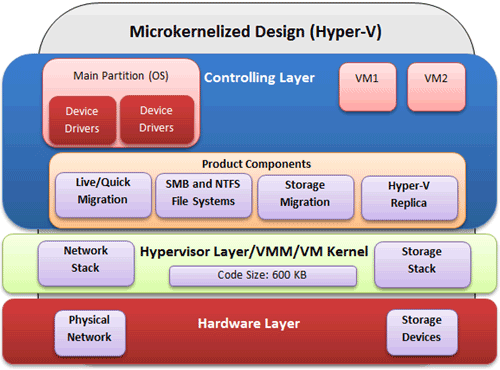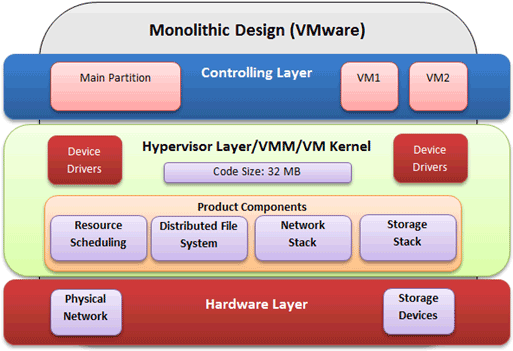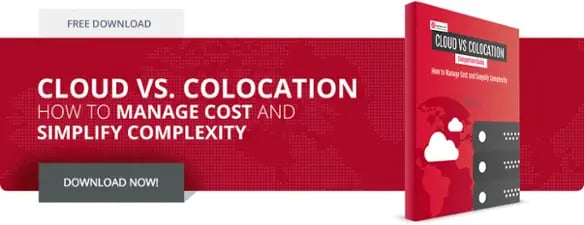Hyper-V vs. VMware: Which Is Best?

Hyper-V vs. VMware: Which is best?
Virtualization remains one of the hottest trends in business IT. Gartner reports that many businesses have over 75% of server workloads virtualized. Whether your organization has already invested heavily in the cloud or is considering a first-time migration, it can be critical to consider the role of a hypervisor in your overall experience.
A hypervisor is computer software, firmware, or hardware that creates and runs virtual machines. The hypervisor presents virtual or guest operating systems to virtual machines and manages the execution of these virtual operating platforms, which can consist of a variety of operating systems. The right hypervisor can ensure ease of use, flexible resource allocation, and minimal disruption to each of the operating systems in use.
Two of the most common choices for hypervisors include vSphere, a VMware product, and Hyper-V, by Microsoft. Join us as we review the pros, cons, and costs of Hyper-V and VMware, so you can decide which is best for you.
At Atlantech Online, we've delivered first-class business telecommunications services to Washington, D.C. and the surrounding areas for over two decades. If you're looking for an experienced partner for virtualization, we'd love to chat.
We built our business to be different than the big telecom giants for all the right reasons, and our long list of happy clients love us for it. Learn more about our commitment to quality of service, peerless boots-on-the-ground support, and flexible offerings here.
What Is Hyper-V?
Microsoft Hyper-V is designed to offer "enterprise-class virtualization" for organizations with a data center or hybrid cloud. This option is a common choice for organizations who want to virtualize workloads, build a private cloud, scale services through a public cloud, or combine all three.
Hyper-V is built into Windows Server, or can be installed as a standalone server, known as Hyper-V Server, both of which can ease the learning curve for virtualization administrators who already have knowledge and background with Microsoft products. It offers a unified set of integrated management tools, regardless of whether organizations are striving to migrate to physical servers, a private cloud, a public cloud, or a "hybrid" mixture of these three options.
Hyper-V Pros
- Can deploy new virtual servers in minutes
- Maintenance does not result in downtime
- Simple live migrations
- Easy backups
- Comprehensive security through Windows Active Directory
-
Lower priced
Hyper-V Cons
- Hyper-V (2012R2) supports a limited number of guest OS choices: see here for a comprehensive list.
- Requires Windows OS upgrades during product lifetime
-
Poor or missing support for RemoteFX and Service Templates in System Center Virtual Machine Manager 2012 R2
What Is VMware vSphere?
VMware vSphere is a popular hypervisor choice for organizations hoping to achieve some degree of virtualization. Now on version 6.0, vSphere is highly configurable, which can make it an attractive choice for companies that are either going fully virtual or opting for a hybrid approach.
There are several different flavors of vSphere available, depending on organizational needs. vSphere Standard, Enterprise Plus, and Operations Management Enterprise Plus offer varying features and degrees of fault tolerance, allowing organizations to select the best coverage for their needs and growth goals.
vSphere Pros
- Intuitive use
- High-quality support availability
- May be an optimal fit for major enterprises
- Broad OS support
- Offers access to governance capabilities
- Transparent page sharing
-
Offers higher guests per host (512 vs. 384)
vSphere Cons
- Free and trial versions do not offer full functionality
-
Reported steep learning curve
Hyper-V and VMware Costs
Hyper-V and vSphere costs depend primarily on the number of processors and operating system environments (OSEs) managed. Licensing for Hyper-V ranges from free to $3,607, though organizations can pay significantly more depending on their processing and OS goals. Licensing for VSphere can range from $995 to $4,245, with additional fees for support, multi-site use, "Operations Management Acceleration," and more.
Both VMware and Hyper-V offer a free version. However, the free and trial versions of VMware are missing some functionality. In contrast, the free version of Hyper-V offers full functionality for individuals who want to give it a test drive.
vSphere vs. Hyper-V: Other Factors to Consider
1. Scalability
The scalability factor of Hyper-V slightly exceeds vSphere. The maximum potential of each factor is detailed in the table below:
| Resource | Hyper-V (R2 2012) | VMWare vSphere Hypervisor | VMWare vSphere 5.5 Hypervisor | |
| Host | Logical Processors | 320 | 320 | 320 |
| Host | Physical Memory | 4TB | 4TB | 4TB |
| Host | Virtual CPUs Per Host | 2,048 | 4,096 | 4,096 |
| VM | Virtual CPUs Per VM | 64 | 8 | 64 |
| VM | Memory Per VM | 1TB | 1TB | 1TB |
| VM | Active VMs Per Host | 1,024 | 512 | 512 |
| VM | Guest NUMA | Yes | Yes | Yes |
| Cluster | Maximum Nodes | 64 | NA | 32 |
| Cluster | Maximum VM | 8,000 | NA | 4,000 |
Data Source: Microsoft
What if your workload is absolutely massive? VMware Enterprise Plus and Hyper-V both permit 64 virtual processors and 1 TB Ram in a single virtual machine.
2. Design Advantages and Disadvantages
ServerWatch highlights the following advantages for VMware and Hyper-V's design:
Hyper-V:

Advantages
- Hypervisor Layer or VMM Kernal doesn't require device drivers for each device.
- Minimized attack surface since the Hpyervisor layer lacks APIs
- Device drivers don't need to by hyperviser-aware.
- Device drivers can be installed in OS running in "controlling layer."
- Hypervisor layer requires less overhead for maintaining device drivers.
- Any other server roles can be installed in controlling layer.
-
Requires less initialization time than VMware
Disadvantages
- Controlling Layer requires an installed OS before Hypervisor can operate.
- If controlling layer OS crashes, all VMs crash.
- Controlling layer requires more overhead.
-
Security depends on the application of Microsoft security updates, which requires all VMS to be taken offline or moved to a different node to avoid downtime.
VMWare:

Advantages:
- No OS required to control all components of virtualization.
-
No security patches needed.
Disadvantages:
- Only works on supported hardware.
- Requires more initialization time.
-
Corrupted code injected in Hypervisor layer can cause delays.
3. Operating System Support
New guest operating systems that are supported by VMware include:
- Oracle Unbreakable Enterprise Kernel Release 3 Quarterly Update 3
- Asianux 4 SP4
- Solaris 11.2
- Ubuntu 12.04.5
- Ubuntu 14.04.1
- Oracle Linux 7
- FreeBSD 9.3
-
Mac OS X 10.10
In addition to Windows operating systems, Hyper-V can support:
- CentOS
- Red Hat Enterprise Linux
- Debian
- Oracle Linux
- SUSE
- Ubuntu
- FreeBSD
4. Performance
Academic research was performed to evaluate the performance of Hyper-V, VMware, and other solutions in a controlled laboratory setting, using methods of evaluation and testing guided by the scientific method. According to the authors of the resulting paper, "we conducted performance experiments using different scenarios on each virtualization approach supported by the latest versions of the mentioned hypervisors."
The results indicated that based on performance factors, Hyper-V outperformed VMware. Full insight into the results of each individual test performed by the researchers, their resarch methods, and results can be viewed here.
5. Licensing Inclusions
TechNet reports that licensing support and inclusions for Hyper-V and VMware stacks up as following.
Microsoft Hyper-V Windows Server 2012 R2 + System Center 2012 R2 Datacenter Editions |
VMware vSphere 5.5 Enterprise Plus + vCenter Server 5.5 |
||
| # of Physical CPUs per License | Supported | Limited Support | With Microsoft, each Datacenter Edition license provides licensing for up to 2 physical CPUs per Host. Additional licenses can be “stacked” if more than 2 physical CPUs are present. With VMware, a vSphere 5.5 Enterprise Plus license must be purchased for each physical CPU. |
| # of Managed OSE’s per License | Unlimited | Unlimited | Both provide ability to manage an unlimited OSE per licensed Host. |
| # of Windows Server VM Licenses per Host | Unlimited | Not Supported | With VMware, Windows Server VM licenses must still be purchased separately. VMware includes licenses for an unlimited # of VMs running SUSE Linux Enterprise Server. |
| Includes Anti-virus / Anti-malware protection | Yes | Yes | |
| Includes full SQL Database Server licenses for management databases | Yes – Up to 1,000 hosts and 25,000 VMs per management server. | No – Must purchase additional database server licenses tfor more than 100 hosts and 3,000 VMs. | |
| Includes licensing for Enterprise Operations Monitoring and Management of hosts, guest VMs and application workloads running within VMs. | Yes – Included in 2012 R2 | No – Operations Monitoring and Management requires separate license. | |
| Includes licensing for Private Cloud Management capabilities – pooled resources, self-service, delegation, automation, elasticity, chargeback/showback | Yes – Included in System Center 2012 R2 | No – Private Cloud Management capabilities require additional cost of VMware vCloud Suite. | |
| Includes management tools for provisioning and managing VDI solutions for virtualized Windows desktops. | Yes – Included in the RDS role of Windows Server 2012. | No – VDI management requires additional cost of VMware Horizon View. | |
| Includes web-based management console | Yes – Included in System Center 2012 App Controller. | Yes – Included in vSphere Web Client. |
Data Source: TechNet
6. Storage and Networking
Storage Capabilities:
| Capability | Hyper-V (2012 R2) | VMware vSphere | VMware vSphere 5.5 Enterprise Plus |
| iSCSI/FC Support | Yes | Yes | Yes |
| Network File System Support | Yes (SMB 3.0) | Yes (NFS) | Yes (NFS) |
| Virtual Fiber Channel | Yes | Yes | Yes |
| 3rd Party Multipathing | Yes | No | Yes (VAMP) |
| Native 4KB Disk Support | Yes | No | No |
| Storage Virtualization | Yes (Spaces) | No | Yes (vSAN) |
| Storage Tiering | Yes | No | Yes |
Data Source: Microsoft
Networking Capabilities:
| Capability | Hyper-V (2012 R2) | VMware vSphere | VMware vSphere 5.5 Enterprise Plus |
| Dynamic Virtual Machine Queue | Yes | NetQueue | NetQueue |
| IPsec Task Offload | Yes | No | No |
| SR-IOV with Live Migration | Yes | No | No |
| Virtual Receive Side Scaling | Yes | Yes (VMXNet3) | Yes (VMXNet3) |
Data Source: Microsoft
For additional information, we recommend the full overview written by Petri.
Hyper-V vs. VMware: The Bottom Line
Success in virtualization requires a strong knowledge of your business requirements, clear goals, and a hypervisor that facilitates ease of use. The popularity of both vSphere and Hyper-V speaks to the products' quality and broad user bases.
It can be natural to feel overwhelmed about selecting a hypervisor, which can be a decision that has an impact on your overall virtualization experience. Atlantech Online has extensive experience helping organizations of all sizes and experience levels achieve their virtualization goals. To speak with a virtualization expert today, click here.


